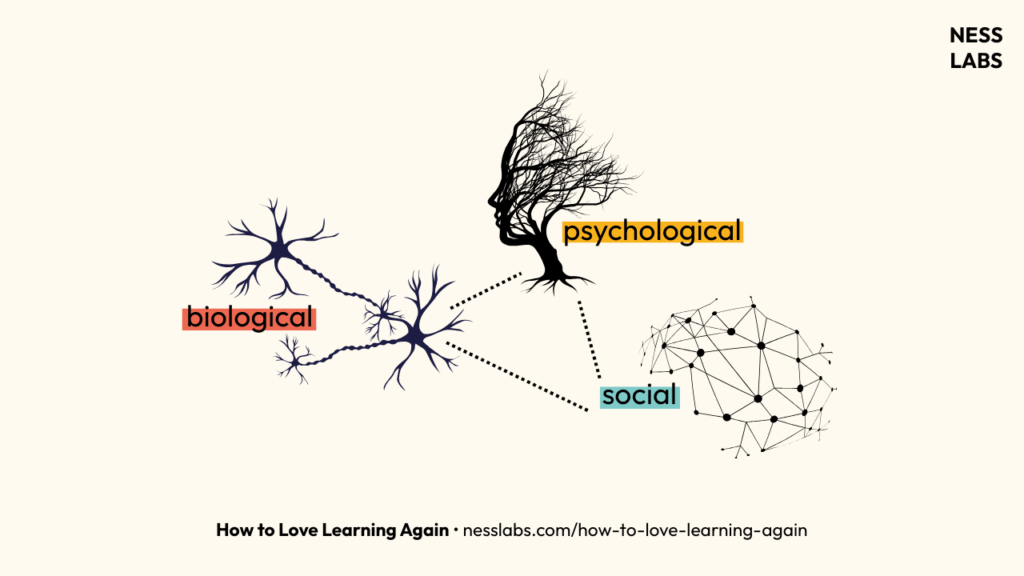I still remember an assignment where our history teacher asked us to create an ‘artifact’ about a historical figure of our choice. I chose Jesus and spent hours at the school library, asking the librarian for every book that mentioned him, and made a mini book with hand-drawn illustrations.
I was completely absorbed in the process and it remains one of my favorite school projects. (although I did a terrible job separating historical fact from later additions and got a bad grade!)
Around the same time, I also remember sitting in my bedroom for hours trying to solve math equations, hating every second of it.
Same brain, same time investment, completely different experience.
Why do we sometimes love learning while other times we can’t wait to escape and something else? How does this affect how well we actually learn? And what can we do about it?

When Your Brain Says “Yes!”
When we’re genuinely curious about something, our brains release dopamine – the same neurotransmitter involved in other rewarding experiences. This creates a positive cycle: curiosity leads to exploration, which leads to discovery, which triggers more dopamine and makes us want to keep going.
But this system only works when we feel safe to explore. When learning feels threatening – i.e. when we’re worried about failing or being judged – our brains shift into survival mode.
The prefrontal cortex, responsible for complex thinking, becomes less effective under stress. That math problem stops being a puzzle to solve and becomes something to endure.
The ingredient that transforms learning from threat to opportunity is agency: when we have confidence and some autonomy over what we learn and how we learn it, and understand why we’re learning it.
But what shapes our sense of agency in the first place? Understanding this can help us create better conditions for loving learning. Three key forces influence our learning experience:
- Biological factors. Your body affects your learning capacity more than you might think. Sleep, nutrition, and your physical environment all influence how you feel about learning. Stress hormones can impair memory formation, but the right level of alertness primes your brain for learning.
- Psychological factors. The difference between being curious about mistakes versus fearing them determines whether you see setbacks as learning opportunities, and past negative experiences can create fear of failure that makes you avoid challenges.
- Social factors. Learning rarely happens in isolation. The expectations and feedback you receive (whether from teachers, managers, peers, or family) shape your relationship with learning. Cultural attitudes about intelligence also influence whether you see learning as natural human behavior or something reserved for “smart people.”
When your biology, your psychology, and your social environment align positively, learning becomes more fun. You retain information better, think more creatively, and persist through challenges. But when they work against you, you tend toward surface-level processing and giving up quickly.
And these patterns compound over time! Early positive experiences build confidence, while negative experiences can create the opposite trajectory, leading to avoidance and deepening this belief that you don’t like learning.
5 Steps to Love Learning Again
Your relationship with learning isn’t fixed. Neural plasticity research shows we can rewire how we respond to learning. The key is starting small and building positive momentum. Here are five practical steps you can try:
1. Decouple the topic. Recognize that hating math doesn’t mean you hate learning – you might just hate how you’ve been taught math. Focus on how you’re learning, not just what you’re learning.
2. Run tiny experiments. Try different approaches to discover what works for you: visual diagrams, talking through problems aloud, or working with others. Mix up your environment, timings and methods.
3. Practice metacognition. Pay attention to how you feel. Track what energizes you and what drains you. Notice when you feel engaged or bored. Identify your optimal learning zone – not so easy that you’re bored but not so hard that you’re overwhelmed.
4. Learn with others. Find a learning community, a study group, or opportunities to teach others. Share your struggles, ask questions and celebrate discoveries together, including what you learn about yourself.
5. Focus on growth. This is about embracing mistakes as data, focusing on what you learned rather than how you performed. An easy way to focus on growth is to track your progress with the PACT framework instead of measuring your success with SMART goals.
Your relationship with learning is shaped by biological, psychological, and social factors that you can influence. Just choose one tiny learning experiment to try this week, notice how it feels, and adjust as you go.
By understanding what makes learning feel good and experimenting with different approaches, you can rebuild a positive relationship with learning.
